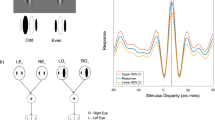Abstract
Temporal detection thresholds are reported from two subjects to dynamic random dot stereograms (DRDSs) of both crossed and uncrossed disparity. The stimuli were 1 degree square, of 0.25 degrees disparity and were presented at 81 positions in a 9 degree square central region. In both subjects crossed disparity stimuli were detected at shorter durations. One subject displayed particularly acute stereoscopic vision and presented a pattern of temporal thresholds increasing gradually with eccentricity. The other subject displayed evidence, particularly in response to uncrossed stimuli, of a ‘stereo-scotoma’ which was not evident in monocular testing or ophthalmologic examination. Criteria used to define ‘stereo-scotoma’ are discussed. It was concluded that, although left-right field differences may be found with a large subject sample, individual factors may be more important in the distribution of stereo sensitivity throughout the portion of visual field tested.
Similar content being viewed by others
References
Breitmeyer B, Julesz B, Kropfl W. Dynamic random dot stereograms reveal an up-down isotropy and a left-right isotropy between cortical hemifields. Science 1975; 187: 269–70.
Burkhalter A, Van Essen DC. Processing of color, form and disparity information in visual areas VP and V2 of ventral extrastriate cortex in the macaque monkey. J of Neurosci 1986; 6: 2327–51.
Carmon A, Bechtoldt HP. Dominance of the right cerebral hemisphere for stereopsis. Neuropsychologia 1969; 7: 29–39.
Cowey A. Cortical maps and visual perception: the Grindley memorial lecture. Quart J Exp Psychol 1974; 31: 1–17.
Durnford M, Kimura D. Right hemisphere specialisation for depth perception reflected in visual field differences. Nature 1971; 231:394–95.
Felleman DJ, Carman GJ, Van Essen DC. Evidence for distinction between areas V2 and VP of macaque extrastriate cortex. Invest Ophthalmol Vis Sci 1984; 25: 278.
Fenelon B, Neill RA, White CT. Evoked potentials to dynamic random dot stereograms in upper, centre, and lower fields. Doc Ophthalmol 1986; 63: 151–56.
Harwerth RS, Rawlings SC. Viewing time and stereoscopic threshold with random-dot stereograms. Am J Opt & Phys Optics 1977; 54: 452–57.
Julesz B. Foundations of Cyclopean Perception. University of Chicago Press, Chicago.
Manning ML, Finlay DC, Neill RA, Frost BG. Detection threshold differences to crossed and uncrossed disparities. Vision Res 1987; 27: 1683–86.
Marr D, Poggio T. Cooperative computation of stereo disparity. Science 1976; 194: 283–87.
Mustillo P. Binocular mechanisms mediating crossed and uncrossed stereopsis. Psychol Bull 1986; 97: 187–201.
Mustillo P. Spatio-temporal processing of binocular disparity information in human stereopsis. Dis Abs Int 1986; 47: 410-B.
Nebes RD. Hemisphere specialisation in commissurotomized man. Psychol Bull 1975; 8: 1–14.
Neill RA, Fenelon B. The objective evaluation of stereopsis. Aust Phys Engng Sci Med 1981; 4: 122–25.
Neill RA, Fenelon B, Manning ML, Frost B. Evoked potentials to dynamic random dot stimuli with varying dot density ratios of disparity to background. Doc Ophthal 1986; 63: 407–415.
Neill RA, Kennewell JA. A clinical test for stereopsis. Aust Phys Engng Sci Med 1979; 2: 463–80.
Poggio GF, Fisher B. Binocular interaction and depth sensitivity in striate and prestriate cortex of behaving rhesus monkeys. J Neurophysiol 1977; 40: 1392–1405.
Poggio GF, Motter BC, Squatrito S, Trotter Y. Responses of neurons in visual cortex (V1 and V2) of the alert macaque to dynamic random-dot stereograms. Vision Res 1985; 25: 397–406.
Richards W. Factors affecting depth perception. AFOSR-TR-73-0439. Final Report. Massachusetts: Air Force Office of Scientific Research and MIT.
Van Essen DC, Maunsell JHR. Hierarchical organisation and functional streams in the visual cortex. TINS 1983; 6: 370–75.
Author information
Authors and Affiliations
Rights and permissions
About this article
Cite this article
Finlay, D.C., Manning, M.L., Dunlop, D.P. et al. Difficulties in the definition of ‘stereoscotoma’ using temporal detection of thresholds of dynamic random dot stereograms. Doc Ophthalmol 72, 161–173 (1989). https://doi.org/10.1007/BF00156706
Issue Date:
DOI: https://doi.org/10.1007/BF00156706




